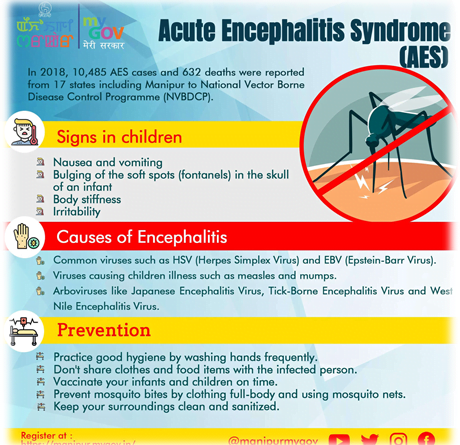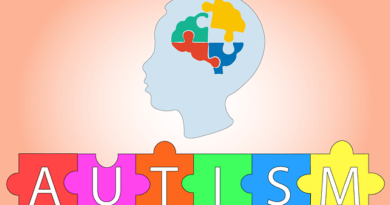Acute Encephalitis Syndrome (AES)
Context:
First AES case of the year suspected in Muzaffarpur.
- Usually AES, locally called chamki bukhar, surfaces during summer in the flood-prone districts of north Bihar.
Acute encephalitis syndrome (AES)
- It is a serious public health problem in India. It is characterized as acute-onset of fever and a change in mental status (mental confusion, disorientation, delirium, or coma) and/or new-onset of seizures in a person of any age at any time of the year.
- The disease most commonly affects children and young adults and can lead to considerable morbidity and mortality.
- Viruses are the main causative agents in AES cases, although other sources such as bacteria, fungus, parasites, spirochetes, chemicals, toxins and noninfectious agents have also been reported over the past few decades.
- Japanese encephalitis virus (JEV) is the major cause of AES in India (ranging from 5%-35%).Herpes simplex virus, Influenza A virus, West Nile virus, Chandipura virus, mumps, measles, dengue, Parvovirus B4, enteroviruses, Epstein-Barr virus and scrub typhus, S.pneumoniae are the other causes of AES in sporadic and outbreak form in India. Nipah virus, Zika virus are also found as causative agents for AES. The etiology in a large number of AES cases still remains unidentified.
History in India
AES due to JEV was clinically diagnosed in India for the first time in 1955 in the southern State of Madras, now Tamil Nadu. During 2018, 10485 AES cases and 632 deaths were reported from 17 states to the National Vector Borne Diseases Control Programme (NVBDCP)*in India, with a case fatality rate around 6 per cent. AES cases were reported mainly from Assam, Bihar, Jharkhand, Karnataka, Manipur, Meghalaya, Tripura, Tamil Nadu, Uttar Pradesh.
Who is affected?
- It predominantly affects population below 15 years.
- There is seasonal and geographical variation in the causative organism.
- JEV has its endemic zones running along the Gangetic plain including states of UP (east), Bihar, West Bengal and Assam, and parts of Tamil Nadu.
The epidemiological analysis of the data collected for the States from 2008-2013 revealed the following:
- Most vulnerable age group between 1-5 years followed by 5-10 years and 10-15 years in that order.
- Least JE infections in infants (0-1 year).
- All the endemic States except Assam start reporting JE cases from July onwards attaining a peak in September-October. In Assam the cases start appearing from February and attain a peak in the month of July.
- Due to circulation of entero-viruses particularly in Eastern Uttar Pradesh AES cases are reported round the year.
Signs and Symptoms
Acute Encephalitis Syndrome (AES) is a general description of the clinical presentation of a disease characterized by high fever altered consciousness mostly in children below 15 years of age.
Clinically, a case of AES is defined as a person of any age, at any time of year with the acute onset of fever and a change in mental status (including symptoms such as confusion, disorientation, coma, or inability to talk) AND/OR new onset of seizures (excluding simple febrile seizures). Other early clinical findings may include an increase in irritability, somnolence or abnormal behavior greater than that seen with usual febrile illness.
Cause of the disease:
Acute Encephalitis Syndrome (AES) is considered a very complex disease as it can be caused by various agents including bacteria, fungi, virus and many other agents.
- Japanese encephalitis virus (JEV) is the major cause of AES in India (ranging from 5%-35%).
- Nipah virus, Zika virus are also found as causative agents for AES.
How is it related to litchi fruits? How it affects?
In India, AES outbreaks in north and eastern India have been linked to children eating unripe litchi fruit on empty stomachs.
Unripe fruit contain the toxins hypoglycin A and methylenecyclopropylglycine (MCPG), which cause vomiting if ingested in large quantities.
- Hypoglycin A is a naturally occurring amino acid found in the unripened litchi that causes severe vomiting (Jamaican vomiting sickness), while MCPG is a poisonous compound found in litchi seeds.
Why it affects undernourished children?
Blood glucose falls sharply causing severe brain malfunction (encephalopathy), leading to seizures and coma, and death in many cases.
- This is because under-nourished children lack sufficient glucose reserve in the form of glycogen and the production of glucose from non-carbohydrate source is blocked midway leading to low blood sugar level.
- This causes serious brain function derangement and seizures.
Prevention
- Increase access to safe drinking water and proper sanitation facilities
- Improve nutritional status of children at risk of JE/AES
- Vector control :
- The preventive measures are directed at reducing the vector (mosquito) density.
- JE vectors are exophillic and endophagic in nature. The risk of transmission increases when the human dwellings and animal sheds particularly piggeries are situated very close to each other. Piggeries may be kept away (4-5 kms) from human dwellings. When they are situated far from each other, the risk of transmission is reduced.
- Personal protection against mosquito bites using insecticide treated mosquito nets.
- Clothing reduces the risk of mosquito biting if the cloth is sufficiently thick or loosely fitting. Long sleeves and trousers with stockings may protect the arms and legs, the preferred sites for mosquito bites. School children should adhere to these practices whenever possible.
- Household insecticidal products, namely mosquito coils, pyrethrum space spray and aerosols have been used extensively for personal protection against mosquitoes. Electric vaporizer mats and liquid vaporizers are more recent additions which are marketed in practically all urban areas.
- Repellents are a common means of personal protection against mosquitoes and other biting insects. These are broadly classified into two categories, natural repellents and chemical repellents. Essential oils from plant extracts are the main natural repellent ingredients, i.e. citronella oil, lemongrass oil and neem oil.
- The reduction in mosquito breeding requires eco-management, as the role of insecticides is limited.
- Vaccination : As per Govt. of India guidelines, 2 doses of JE vaccine have been approved to be included in UIP to be given one along with measles at the age of 9 months and the second with DPT booster at the age of 16-24 months w.e.f. April, 2013.
National Programme for Prevention and Control of Japanese Encephalitis/Acute Encephalitis Syndrome
Several government initiatives have been undertaken to educate and improve the hygiene of people living in the JE endemic zones. Government and non-government organizations have been instrumental in providing proper nutrition to the AES-affected population as most of the affected people belong to the lower economic strata of the society.
Govt. of India, as part of the National Programme for Prevention & Control of JE/AES, follows a multi pronged strategy encompassing preventive (sanitation, safe drinking water, improvement in nutrition etc.), case management (capacity building of medical and para-medical staff, referral etc.) and rehabilitation (physical and social rehabilitation of disabled children), measures to address the problems relating to JE/AES.




